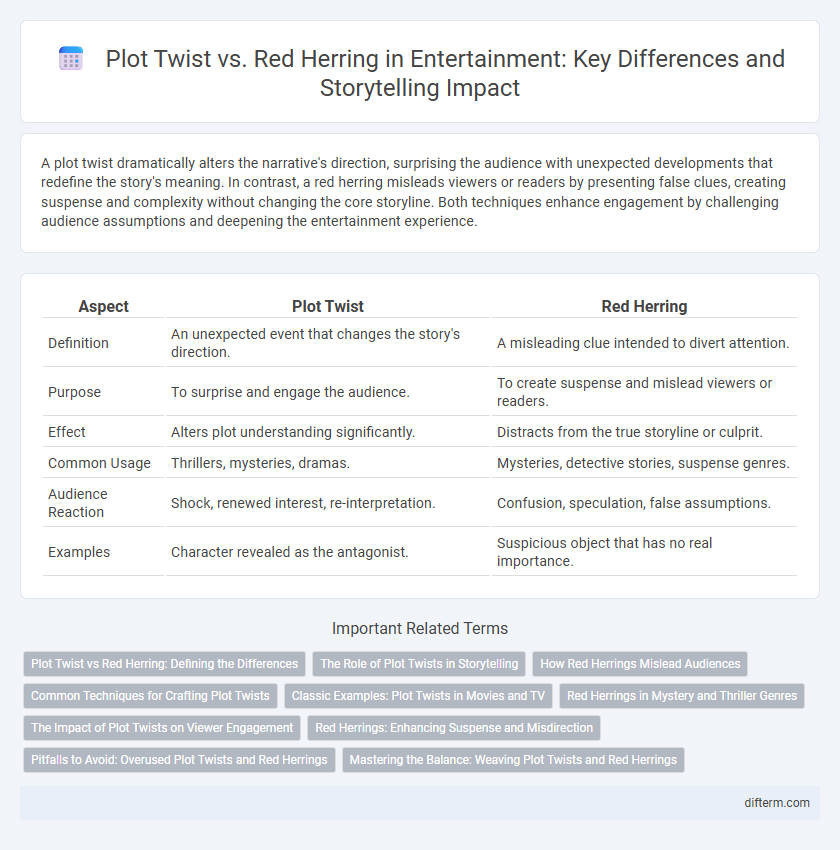A plot twist dramatically alters the narrative's direction, surprising the audience with unexpected developments that redefine the story's meaning. In contrast, a red herring misleads viewers or readers by presenting false clues, creating suspense and complexity without changing the core storyline. Both techniques enhance engagement by challenging audience assumptions and deepening the entertainment experience.
Table of Comparison
| Aspect | Plot Twist | Red Herring |
|---|---|---|
| Definition | An unexpected event that changes the story's direction. | A misleading clue intended to divert attention. |
| Purpose | To surprise and engage the audience. | To create suspense and mislead viewers or readers. |
| Effect | Alters plot understanding significantly. | Distracts from the true storyline or culprit. |
| Common Usage | Thrillers, mysteries, dramas. | Mysteries, detective stories, suspense genres. |
| Audience Reaction | Shock, renewed interest, re-interpretation. | Confusion, speculation, false assumptions. |
| Examples | Character revealed as the antagonist. | Suspicious object that has no real importance. |
Plot Twist vs Red Herring: Defining the Differences
A plot twist dramatically changes the story's direction, revealing unexpected outcomes that reshape the audience's understanding of key events or characters. A red herring misleads the audience by introducing false clues designed to divert attention from the actual solution or truth. While both techniques enhance suspense, plot twists deliver genuine surprises, whereas red herrings create deliberate distractions within the narrative.
The Role of Plot Twists in Storytelling
Plot twists redefine narrative direction by revealing unforeseen outcomes that challenge audience expectations, enhancing engagement and emotional impact. Red herrings serve as deliberate distractions, misleading viewers or readers to create suspense and mystery before the ultimate reveal. Together, these elements drive complex storytelling by balancing deception with surprise, enriching the overall entertainment experience.
How Red Herrings Mislead Audiences
Red herrings mislead audiences by introducing false clues that divert attention from the actual outcome, creating a deceptive narrative path. These misleading elements are strategically placed to manipulate viewer expectations, often resulting in surprise when the true plot unfolds. Unlike plot twists that reveal unexpected truths, red herrings serve primarily to confuse and obscure the storyline.
Common Techniques for Crafting Plot Twists
Common techniques for crafting plot twists include misdirection, where writers use red herrings to divert the audience's attention from the true outcome, creating surprise when the twist is revealed. Skilled storytelling employs subtle clues and inconsistencies that only become clear in hindsight, enhancing the impact of the twist. Effective plot twists often balance plausibility with unpredictability, ensuring the narrative remains coherent while delivering unexpected developments.
Classic Examples: Plot Twists in Movies and TV
Classic examples of plot twists in movies and TV include "The Sixth Sense," where the revelation of the protagonist being dead reframes the entire narrative, and "Game of Thrones," featuring the unexpected Red Wedding that subverts viewer expectations. Red herrings, often employed in mystery genres like "Sherlock" or "Gone Girl," deliberately mislead the audience to obscure the true culprit or outcome. These storytelling techniques enhance engagement by challenging assumptions and creating suspense through well-crafted narrative misdirection.
Red Herrings in Mystery and Thriller Genres
Red herrings are deliberate misdirections used in mystery and thriller genres to divert the audience's attention from the true plot, enhancing suspense and complexity. These false clues or suspects create layers of deception, making the resolution more surprising and engaging. Effective use of red herrings challenges viewers to question narrative assumptions and deepens the immersive experience of the storyline.
The Impact of Plot Twists on Viewer Engagement
Plot twists significantly enhance viewer engagement by defying audience expectations and injecting unpredictability into the narrative, fostering emotional investment and discussion. Unlike red herrings, which serve as deliberate misdirections to obscure the true outcome, plot twists pivot the storyline to reveal unexpected truths, deepening complexity and character development. Studies on viewer behavior indicate that well-executed plot twists increase retention rates, social media interaction, and overall satisfaction with entertainment content.
Red Herrings: Enhancing Suspense and Misdirection
Red herrings serve as deliberate narrative devices designed to mislead audiences and heighten suspense, creating complex layers of intrigue within a story. By diverting attention from the actual resolution, red herrings enhance emotional engagement and maintain unpredictability. Effective use of red herrings transforms simple plots into captivating mysteries that keep viewers guessing until the final reveal.
Pitfalls to Avoid: Overused Plot Twists and Red Herrings
Overusing plot twists and red herrings can lead to audience fatigue and diminished story credibility, causing viewers to become skeptical of any surprising developments. Predictable or excessive twists undermine narrative tension and weaken character arcs, reducing emotional impact. Writers should balance surprise with coherence, ensuring plot devices enhance rather than detract from the overall storytelling experience.
Mastering the Balance: Weaving Plot Twists and Red Herrings
Mastering the balance between plot twists and red herrings is essential for creating engaging narratives in entertainment. Plot twists deliver unexpected shifts that redefine the story's direction, while red herrings strategically mislead the audience without compromising the ultimate resolution. Successful storytelling weaves both elements seamlessly, maintaining suspense and enhancing the depth of the plot.
plot twist vs red herring Infographic

 difterm.com
difterm.com